Abstract
1. In anaesthetized spontaneously breathing cats, the sensory component of the vagal nerves was sectioned at the level of nodose ganglion, using a method described previously (Mei, 1966; Mei & Dussardier, 1966).
2. The strength of the Hering—Breuer reflex (inhibitory ratio, i.e. T1/T0) provided a test for effectiveness of section of vagal afferents, particularly respiratory afferents. On the other hand, by studying the cardiac and bronchomotor effects induced by electrical stimulation of the supranodose portion of the vagal nerve, it was possible to test the integrity of the efferent vagal component.
3. Unilateral right sensory vagotomy was followed by a 29% reduction in total pulmonary resistance.
4. Section of the contralateral sensory vagal component (sensory bivagotomy), produced a weak supplementary effect (total decrease of total pulmonary resistance: 31%).
5. No additive bronchomotor effect could be observed after the bilateral section of efferent vagal fibres (total bivagotomy).
6. In intact cats, blockade of the two vagal nerves by procaine induced a decrease in pulmonary resistance similar to those produced by the sensory bivagotomy (23%). This bronchodilatator effect was concomitant with a complete disappearance of the C wave of the compound vagal potential.
7. Intravenous injection of phenyl diguanide, immediately after the blockade of the C vagal fibres by procaine did not modify bronchomotor tone. This result confirms that the C pulmonary afferents, which are activated by phenyl diguanide, are mainly involved in this mechanism.
8. The pulmonary irritant receptors seem to play a minor role. In fact, the I.V. administration of histamine under the same conditions, provides evidence that the corresponding neurones (small sized myelinated fibres) are potent during the procaine application.
9. From these results, it appears that bronchoconstrictor vagal tone has an exclusive peripheral origin and that pulmonary endings, in particular those connected with non-medullated fibres, are probably involved in this mechanism.
Full text
PDF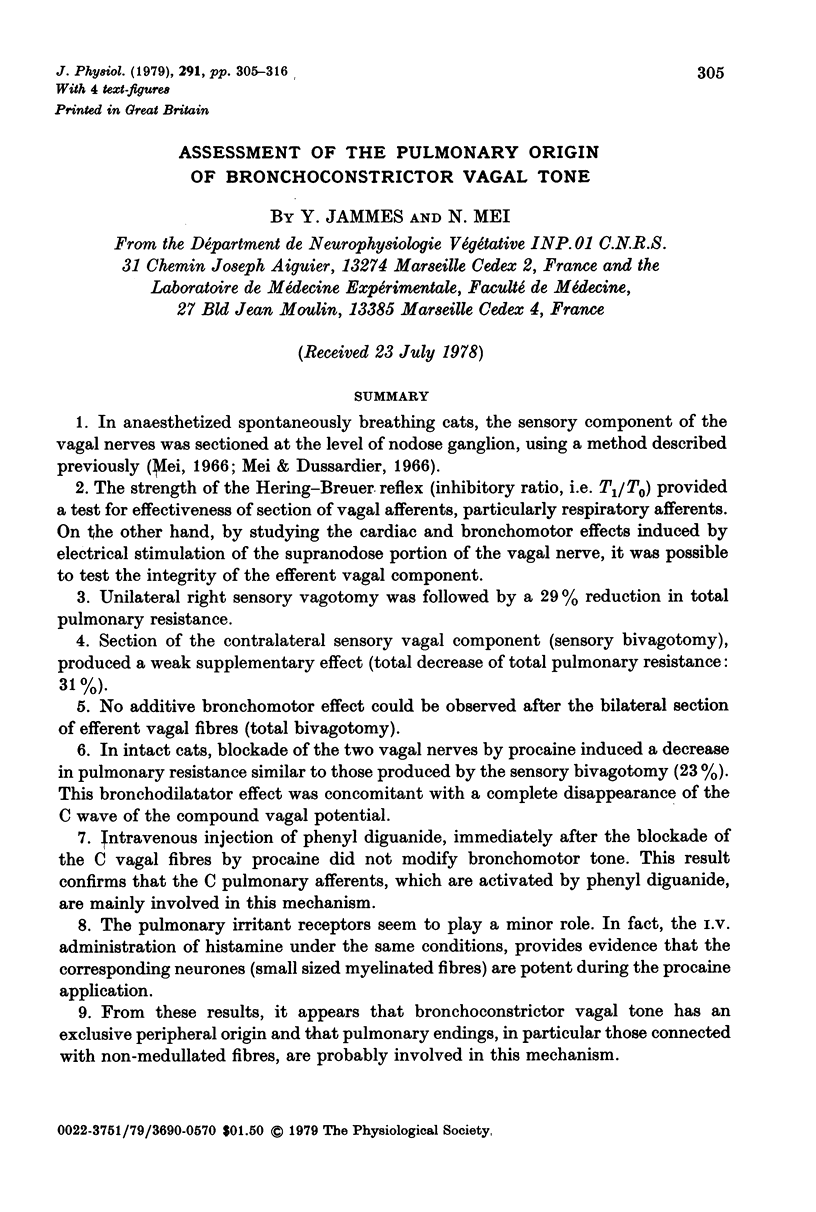
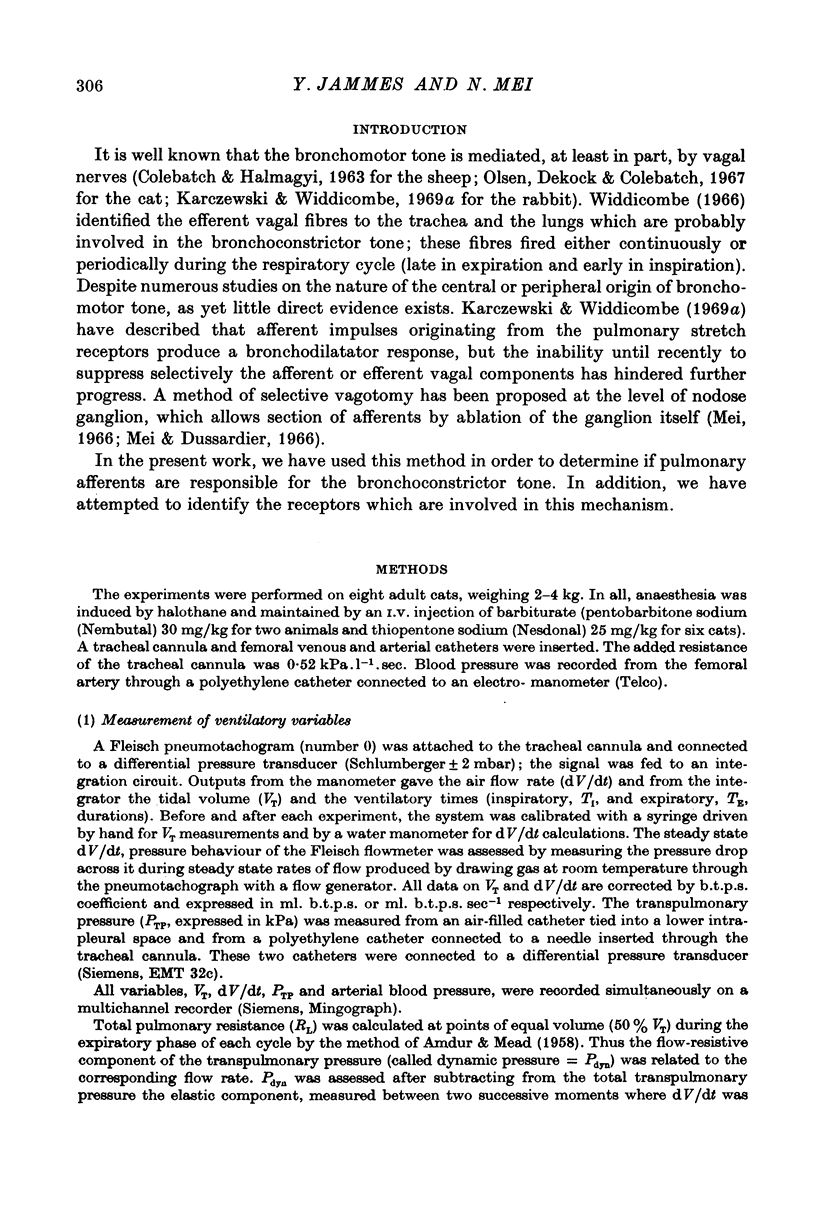
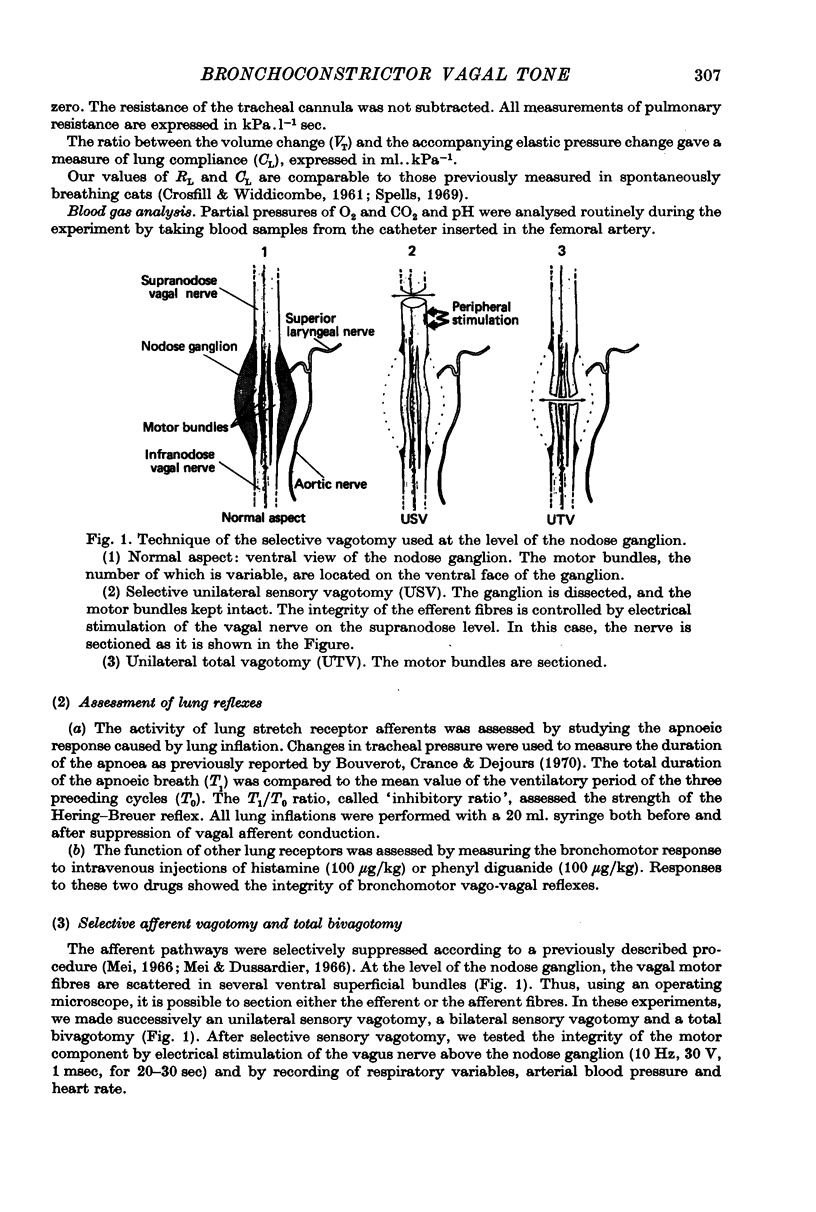
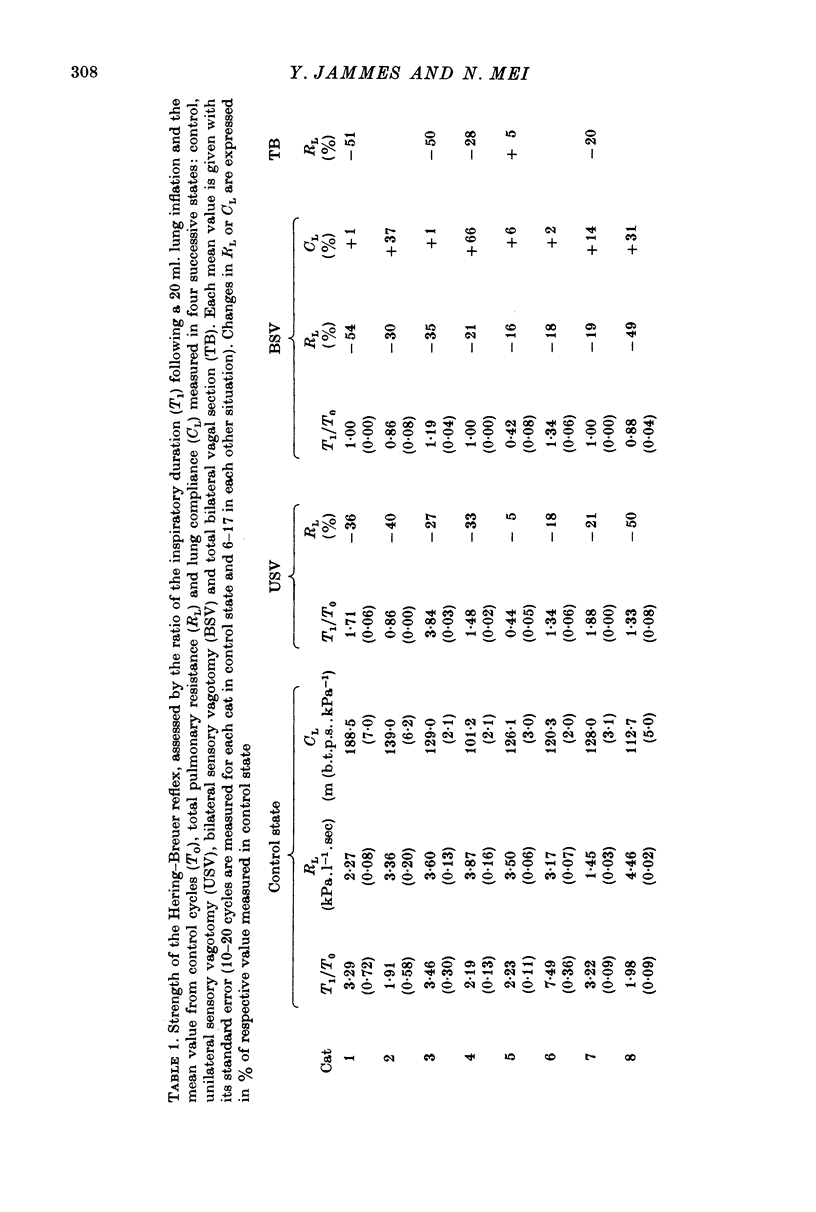
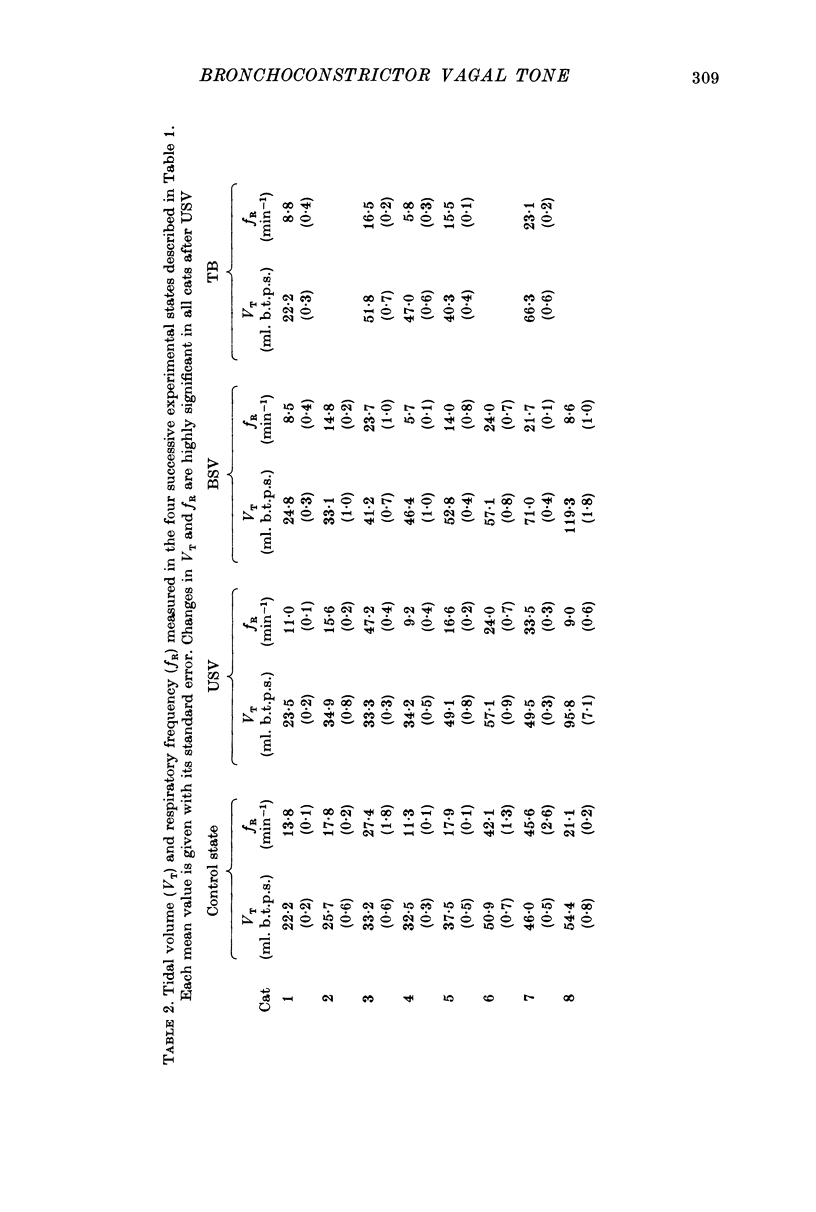
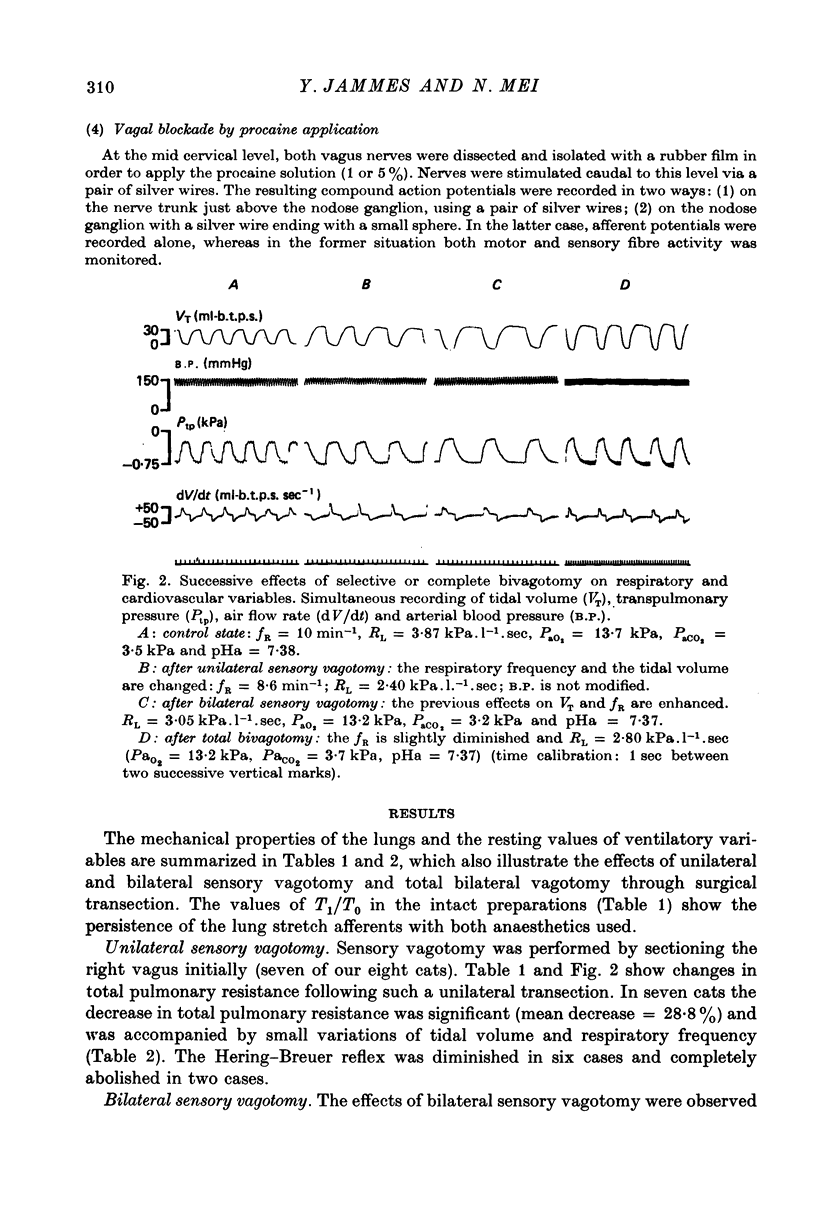
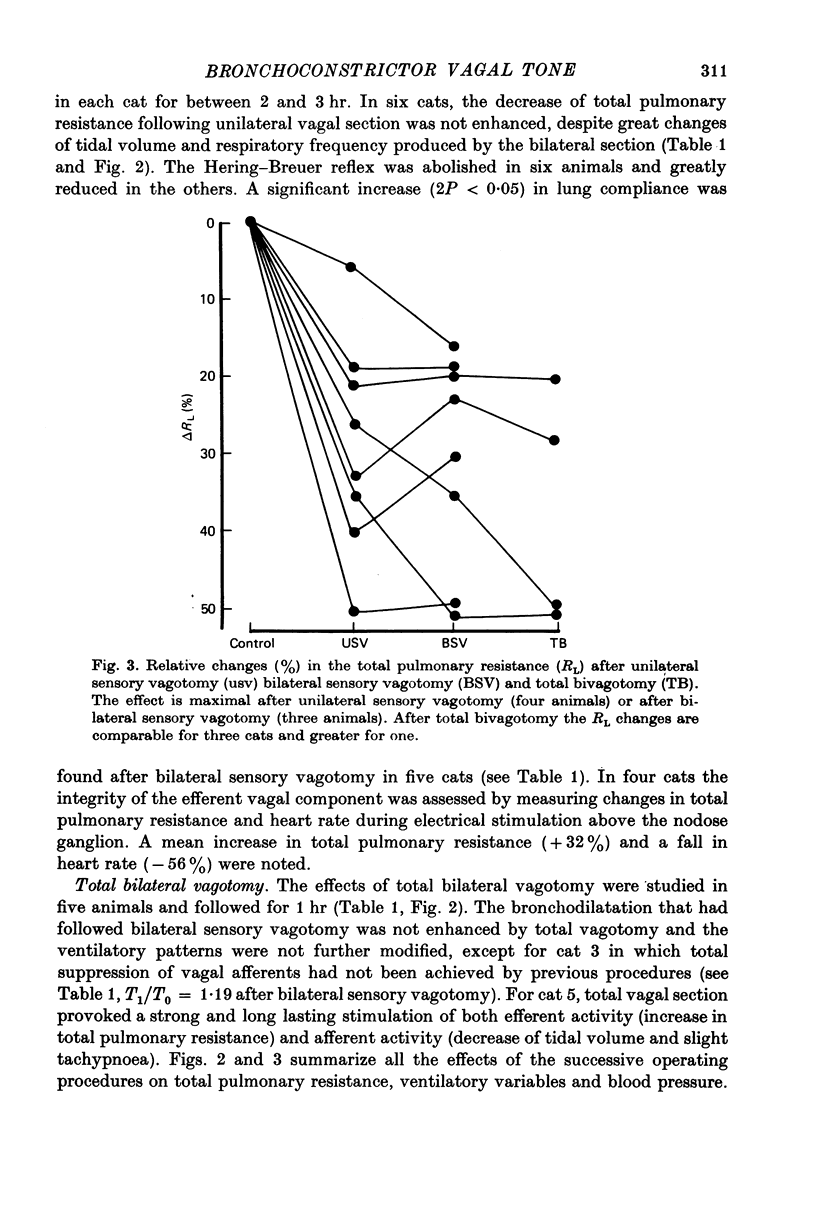
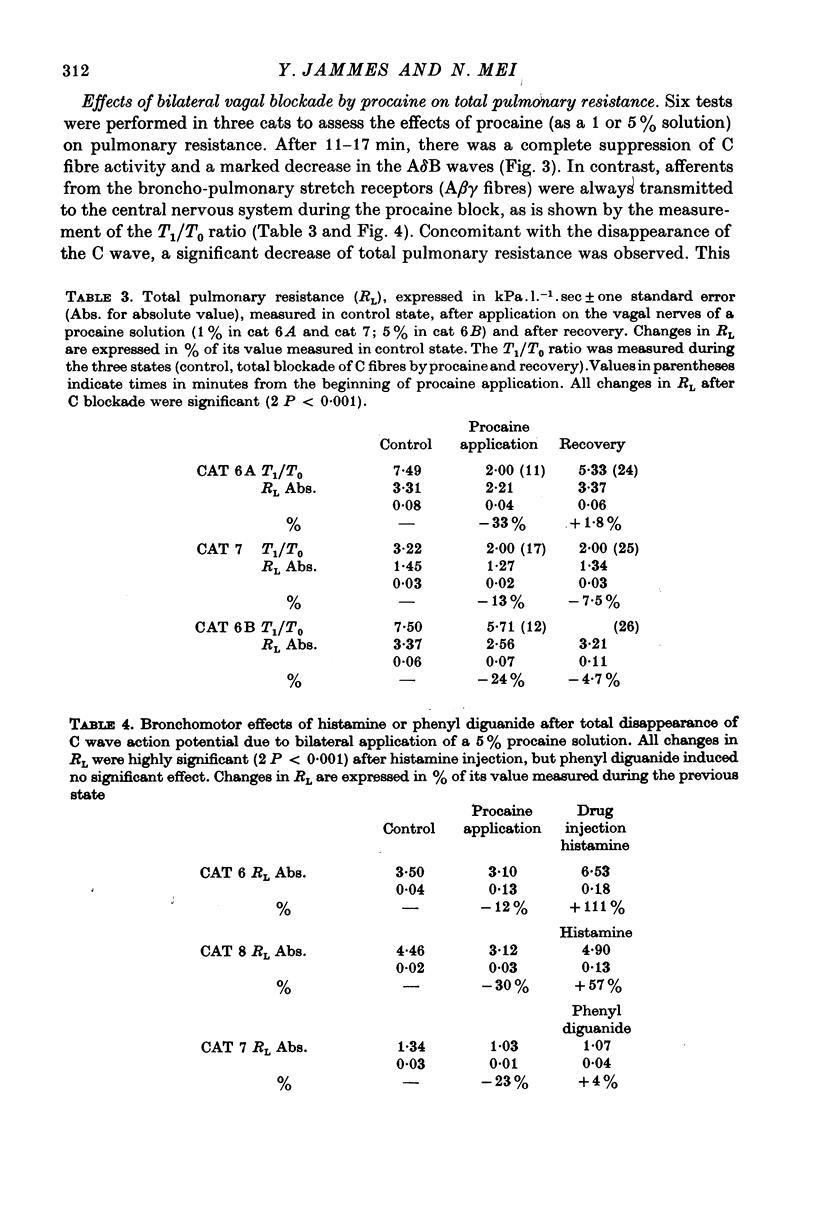
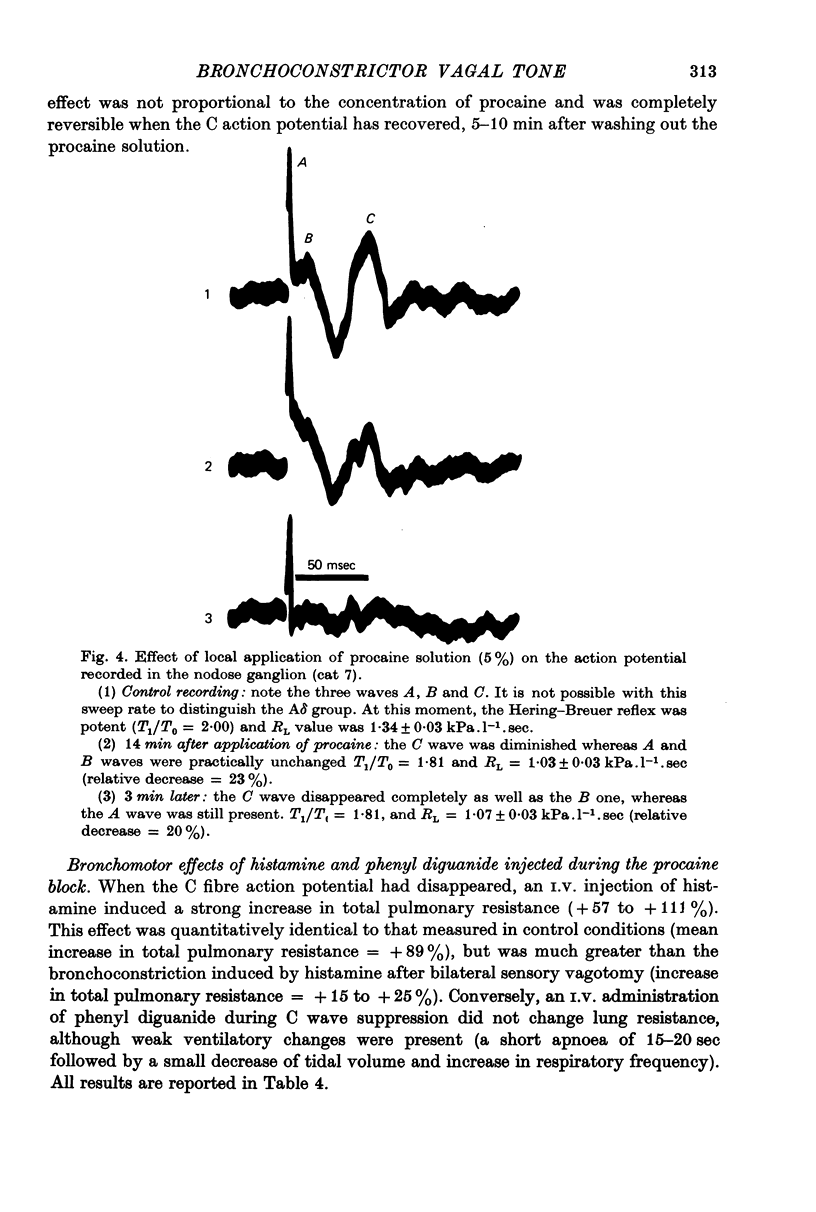
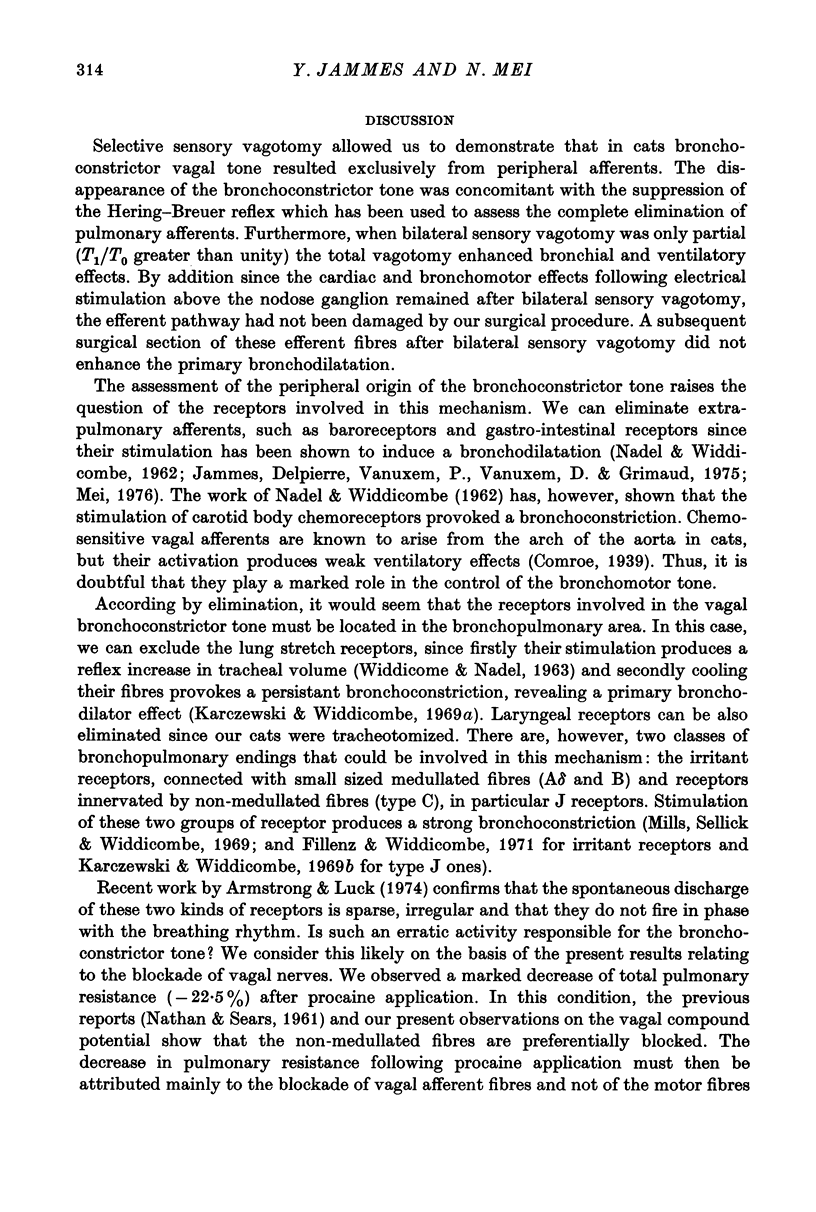
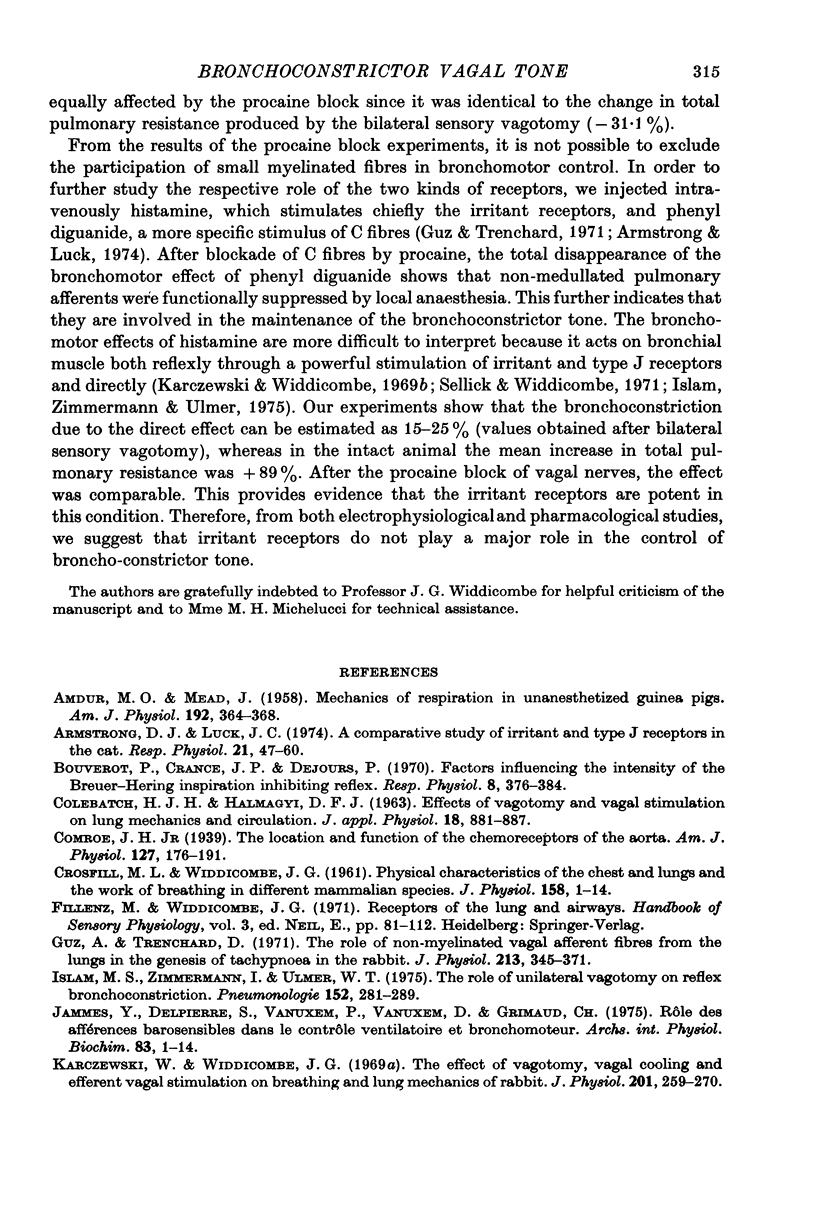
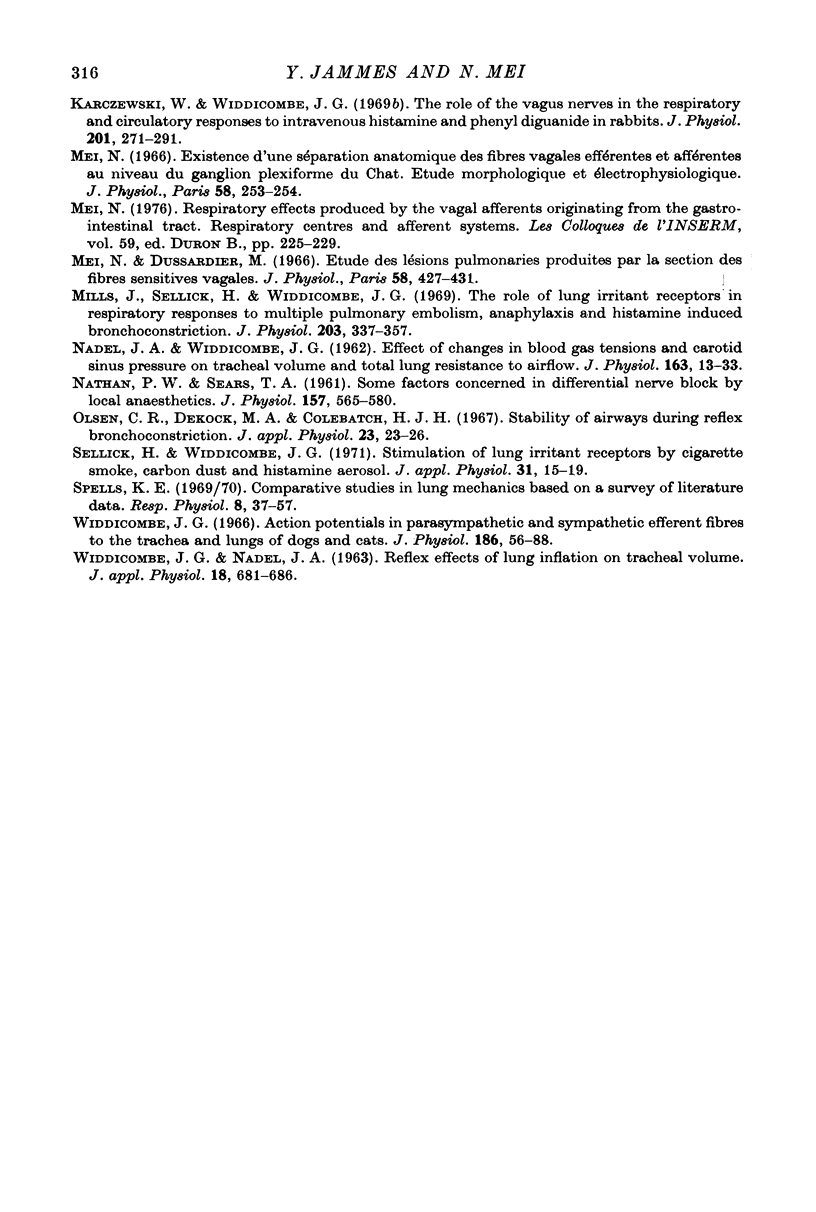
Selected References
These references are in PubMed. This may not be the complete list of references from this article.
- AMDUR M. O., MEAD J. Mechanics of respiration in unanesthetized guinea pigs. Am J Physiol. 1958 Feb;192(2):364–368. doi: 10.1152/ajplegacy.1958.192.2.364. [DOI] [PubMed] [Google Scholar]
- Armstrong D. J., Luck J. C. A comparative study of irritant and type J receptors in the cat. Respir Physiol. 1974 Jul;21(1):47–60. doi: 10.1016/0034-5687(74)90006-1. [DOI] [PubMed] [Google Scholar]
- Bouverot P., Crance J. P., Dejours P. Factors influencing the intensity of the Breuer-Hering inspiration-inhibiting reflex. Respir Physiol. 1970 Mar;8(3):376–384. doi: 10.1016/0034-5687(70)90044-7. [DOI] [PubMed] [Google Scholar]
- COLEBATCH H. J., HALMAGYI D. F. EFFECT OF VAGOTOMY AND VAGAL STIMULATION ON LUNG MECHANICS AND CIRCULATION. J Appl Physiol. 1963 Sep;18:881–887. doi: 10.1152/jappl.1963.18.5.881. [DOI] [PubMed] [Google Scholar]
- CROSFILL M. L., WIDDICOMBE J. G. Physical characteristics of the chest and lungs and the work of breathing in different mammalian species. J Physiol. 1961 Sep;158:1–14. doi: 10.1113/jphysiol.1961.sp006750. [DOI] [PMC free article] [PubMed] [Google Scholar]
- Guz A., Trenchard D. W. The role of non-myelinated vagal afferent fibres from the lungs in the genesis of tachypnoea in the rabbit. J Physiol. 1971 Mar;213(2):345–371. doi: 10.1113/jphysiol.1971.sp009386. [DOI] [PMC free article] [PubMed] [Google Scholar]
- Islam M. S., Zimmermann I., Ulmer W. T. The role of unilateral vagotomy on reflex bronchoconstriction. Pneumonologie. 1975 Nov 14;152(4):281–289. doi: 10.1007/BF02094942. [DOI] [PubMed] [Google Scholar]
- Jammes Y., Delpierre S., Vanuxem P., Vanuxem D., Grimaud C. Role des afférences barosensibles dans le controle ventilatoire et bronchomoteur. Arch Int Physiol Biochim. 1975 Feb;83(1):1–14. doi: 10.3109/13813457509069834. [DOI] [PubMed] [Google Scholar]
- Karczewski W., Widdicombe J. G. The effect of vagotomy, vagal cooling and efferent vagal stimulation on breathing and lung mechanics of rabbits. J Physiol. 1969 Apr;201(2):259–270. doi: 10.1113/jphysiol.1969.sp008754. [DOI] [PMC free article] [PubMed] [Google Scholar]
- Karczewski W., Widdicombe J. G. The role of the vagus nerves in the respiratory and circulatory responses to intravenous histamine and phenyl diguanide in rabbits. J Physiol. 1969 Apr;201(2):271–291. doi: 10.1113/jphysiol.1969.sp008755. [DOI] [PMC free article] [PubMed] [Google Scholar]
- Mei N., Dussardier M. Etude des lésions pulmonaires produites par la section des fibres sensitives vagales. J Physiol (Paris) 1966 Jul-Aug;58(4):427–431. [PubMed] [Google Scholar]
- Mills J. E., Sellick H., Widdicombe J. G. Activity of lung irritant receptors in pulmonary microembolism, anaphylaxis and drug-induced bronchoconstrictions. J Physiol. 1969 Aug;203(2):337–357. doi: 10.1113/jphysiol.1969.sp008867. [DOI] [PMC free article] [PubMed] [Google Scholar]
- NADEL J. A., WIDDICOMBE J. G. Effect of changes in blood gas tensions and carotid sinus pressure on tracheal volume and total lung resistance to airflow. J Physiol. 1962 Aug;163:13–33. doi: 10.1113/jphysiol.1962.sp006956. [DOI] [PMC free article] [PubMed] [Google Scholar]
- NATHAN P. W., SEARS T. A. Some factors concerned in differential nerve block by local anaesthetics. J Physiol. 1961 Aug;157:565–580. doi: 10.1113/jphysiol.1961.sp006743. [DOI] [PMC free article] [PubMed] [Google Scholar]
- Olsen C. R., DeKock M. A., Colebatch H. J. Stability of airways during reflex bronchoconstriction. J Appl Physiol. 1967 Jul;23(1):23–26. doi: 10.1152/jappl.1967.23.1.23. [DOI] [PubMed] [Google Scholar]
- Sellick H., Widdicombe J. G. Stimulation of lung irritant receptors by cigarette smoke, carbon dust, and histamine aerosol. J Appl Physiol. 1971 Jul;31(1):15–19. doi: 10.1152/jappl.1971.31.1.15. [DOI] [PubMed] [Google Scholar]
- Spells K. E. Comparative studies in lung mechanics based on a survey of literature data. Respir Physiol. 1969 Dec;8(1):37–57. doi: 10.1016/0034-5687(69)90043-7. [DOI] [PubMed] [Google Scholar]
- WIDDICOMBE J. G., NADEL J. A. Reflex effects of lung inflation on tracheal volume. J Appl Physiol. 1963 Jul;18:681–686. doi: 10.1152/jappl.1963.18.4.681. [DOI] [PubMed] [Google Scholar]
- Widdicombe J. G. Action potentials in parasympathetic and sympathetic efferent fibres to the trachea and lungs of dogs and cats. J Physiol. 1966 Sep;186(1):56–88. doi: 10.1113/jphysiol.1966.sp008020. [DOI] [PMC free article] [PubMed] [Google Scholar]


